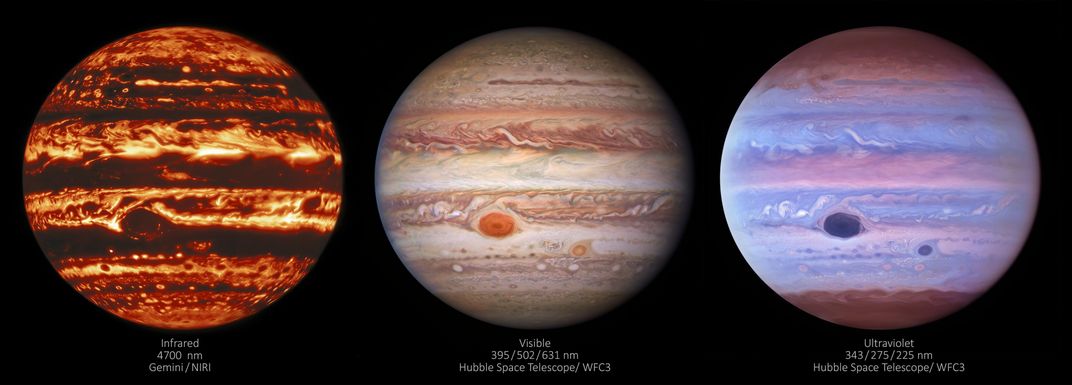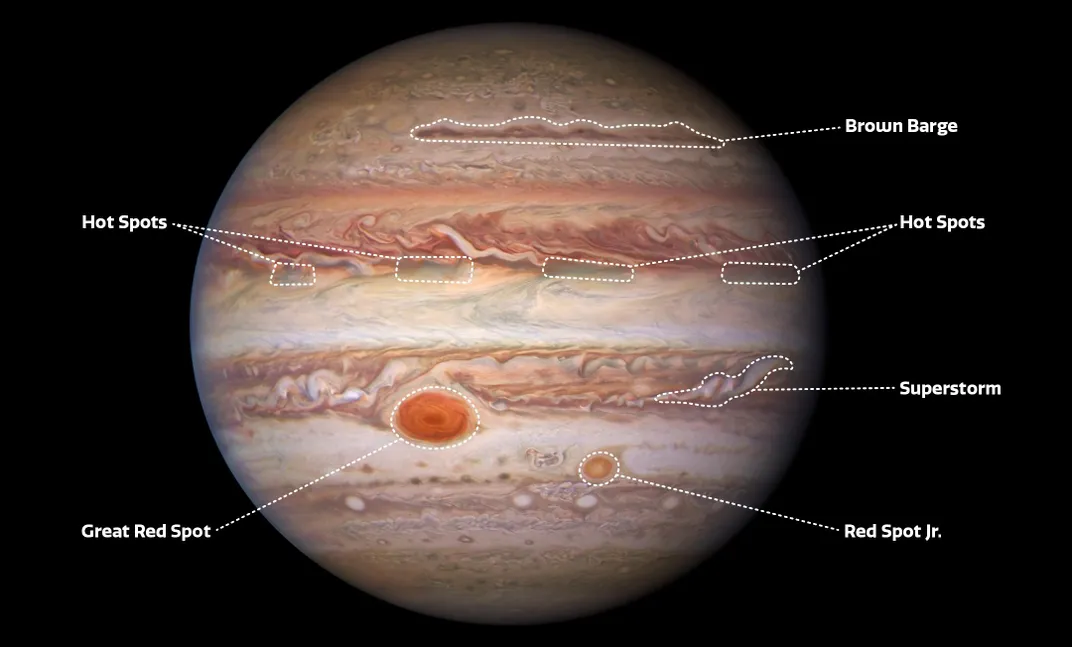Peer Into Jupiter’s Gassy Atmosphere With These Stunning New Photos
The images taken at various wavelengths reveal details about the gas giant’s stormy atmosphere
/https://tf-cmsv2-smithsonianmag-media.s3.amazonaws.com/filer/e1/a4/e1a46781-b6a7-46c3-80d6-53b92fbaca7a/noirlab2116d.jpg)
Jupiter, the largest planet in the solar system, has a swirly atmosphere of frigid clouds consisting of ammonia and water. These clouds float along in a gaseous envelope of hydrogen and heliumm, creating Jupiter's famous marbled appearance.
Using the Hubble Space Telescope and the Gemini North Observatory in Hawaiʻi, researchers captured breathtaking images of gas giant's swirls and stripes in different wavelengths of light. The new photos are aiding scientists in deciphering what drives the formation of Jupiter's turbulent storms, reports Tereza Pultarova for Space.com.
The three photographs analyzed by researchers at the United States National Optical-Infrared Astronomy Research Laboratory (NOIRLab) were taken on January 11, 2017. Each image showed a drastic change in Jupiter's appearance when viewed in infrared, visible, and ultraviolet wavelengths. Each wavelength of light highlights atmospheric details of the planet and offers insights into Jupiter's prominent features, such as the planet's superstorms, massive cyclones, and its iconic Great Red Spot, reports Ashley Strickland for CNN.
The Hubble Space Telescope photographed the gas giant in visible and ultraviolet light while the Gemini North Observatory imaged Jupiter in infrared. In visible light, Jupiter looks familiar with its milky swirls and red streaks. In ultraviolet light, the planet looks like a pastel watercolor orb. However, Jupiter's effervescent and peaceful landscape transforms into a fiery, lava-like scene—where its deep red bands become rings of fire—when viewed in infrared, reports Issac Schultz for Gizmodo.
The Great Red Spot is seen in both visible and ultraviolet light, but it disappears into the background as a black splotch in the infrared image. When comparing visible light images to infrared light images, the dark blob representing the Great Red Spot appears larger in the infrared light, Space.com reports. This difference in size occurs because distinct atmospheric properties and structures are revealed at different wavelengths, the NOIRLab researchers explain in a statement. In all three images, Jupiter's cloudy bands are visible.
By comparing the infrared image and the visible light images, the researchers also found that the milky-colored stripes that look like clouds are actually holes in the atmospheric layer, CNN reports. In the thermal infrared image, researchers could see how Jupiter's heat escapes into space. The Great Red Spot is not visible in the infrared image because it is riddled with holes that let heat escape into space, the researchers explain in a NOIRLab blog post.
Within the infrared image, a cyclonic vortex was observed as a bright streak nearly 45,000 miles long towards the planet's Northern hemisphere, Space.com reports. When viewing the cyclonic vortex in a normal image of Jupiter, it appears as a brown streak. But the cyclonic vortex almost disappears when viewed in ultraviolet light, under a stratospheric haze.
Researchers combined the observations from the three images in varying wavelengths with signals detected by NASA's Juno spacecraft to show how lightning storms on Jupiter form. Juno detected lightning blast signals that correlated with the Hubble Telescope's observations of bright clouds in the same regions. The Gemini North Observatory confirmed that the active regions where Juno detected lightning signals were dotted with bright infrared areas created by turbulent downdrafts in the clouds. Using all collected data, the researchers mapped Jupiter's cloud structure and identified where the different types of cyclonic vortices are located.
The researchers hope to use these results to further understand weather patterns on Jupiter and to find out how and why the Great Red Spot is shrinking, CNN reports.
/https://tf-cmsv2-smithsonianmag-media.s3.amazonaws.com/accounts/headshot/gamillo007710829-005_0.png)

/https://tf-cmsv2-smithsonianmag-media.s3.amazonaws.com/filer/8d/50/8d5001d9-0b3c-4bf4-9afe-49cc8fae88f5/noirlab2116a.jpeg)
/https://tf-cmsv2-smithsonianmag-media.s3.amazonaws.com/filer/97/c1/97c1147d-891c-4d65-a2f5-15c79d74f811/noirlab2116c.jpeg)

/https://tf-cmsv2-smithsonianmag-media.s3.amazonaws.com/accounts/headshot/gamillo007710829-005_0.png)